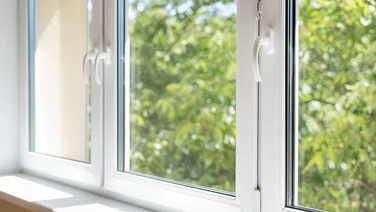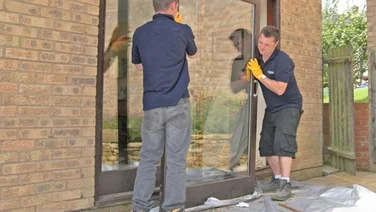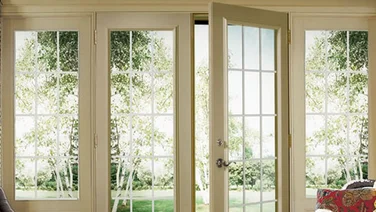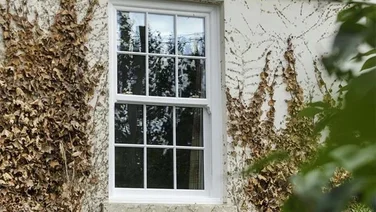- Window draughts are a major cause of energy loss
- There are multiple cost-effective ways that windows can be draught proofed
- However, greater investment is likely to lead to larger savings overall
If you can feel cold air when you stand near your window, it’s more than likely that you have draughty windows.
If there’s a draught in your house, there’s a big chance it could be coming from your windows. The gaps might be small and hard to see, but they have the potential to make your house cold. In fact, Historic England estimates that around one-fifth of heating is lost due to draughty windows.
But draught-proofing around windows and doors could save you around £40 a year in Britain and £45 in Northern Ireland.
In this guide, we’ll offer 11 tips to draught-proof your home, from using self-adhesive strips to hanging heavy curtains.

How to draught-proof your windows
There are multiple ways to draught-proof your windows, and naturally the options vary depending on your budget and the type of windows you have. Here are some of the best approaches:
Use self-adhesive foam strips
This is also known as weather stripping. Whatever you choose to call it, with a roll costing under £5, this is a cost-effective and easy way to fill gaps in your windows.
There are a wide range of tapes available, so sizing accurately is essential, both in terms of the width you buy, but also the length you cut the tape. Too short and the gap will still be exposed, too long (or too wide) and your windows won’t close, creating more of a problem.
Be aware that self-adhesive tape won’t work well on sash windows.
Install brush strips
More flexible than tape, brush strips, which can be made from plastic, wood or aluminium, allow for the windows to move up and down.
Brush strips last longer than self-adhesive tape, so are generally better for the environment, and have the additional benefits of keeping out dirt and small insects, too.
Brush strips can be trickier to install than self-adhesive tape, so you may want to consider professional help to make sure they are fitted correctly.
Fill gaps with a silicone sealant
Silicone sealant is only appropriate for windows that don’t open, but, similarly to self-adhesive strips, this is an inexpensive and easy way to deal with any draughty window gaps, with sealant available for under £5.
Make sure you thoroughly clean the windows before you apply the sealant, or it may impact how long it lasts. You’ll also want to make sure that the sealant goes onto the window frame, and not the actual window, or it will look very messy.
Sealant is generally considered more effective than caulking (see below) when you’re dealing with environments that tend to get a lot of heat or moisture.
Temporarily seal windows
If you can live without opening your windows all through the winter – and you would still be able to leave safely if there were a fire – then sealing your windows shut can be an effective short-term way to help block out draughts.
One of the easiest – and cheapest – ways to do this is by caulking. Caulking is relatively straight-forward to do (this video guide shows you how). It’s less flexible than silicone, but since this is a temporary solution that shouldn’t matter too much.

Hang heavy curtains
Curtains have been used for centuries to keep out drafts, and a well placed, heavy curtain can still be very effective. Just remember it needs to be hung fairly close to the window or it won’t do its job.
Curtains will work even better if they’re lined. Ideally they would also reach to the floor to limit the opportunities for the cold air to get through.
You might also want to consider thermal curtains, which have multiple layers sewn together to create greater insulation.
Not only will closing the curtains keep the heat in in winter, but it will also keep heat out in the summer.
Add window film
Much like double glazing, adding film to your window draughts creates an additional barrier to stop heat getting out and cold air from coming in.
Easy to install and cost effective (some rolls sell for under £5), window film can be put to a variety of uses: keeping drafts out, reducing glare from sunlight, protecting your windows and increasing privacy. There is also a range of styles, from patterned and frosted to mirrored.
Use a door snake
Whether you make your own with old socks, or buy something cute (sausage dog draft excluders start at around £15), door snakes can be as effective at tackling window draughts, as they are for doors.
Door snakes work by stopping cold air from coming in through your home, and they can also work, to some degree, as a kind of air filter. Make sure you pick the right size for your window.
Install window quilts
Generally more popular in North America, window quilts cover the entire window and absorb any cold air. Window quilts can make a huge difference if you live in a particularly cold climate, and are also useful to keep rooms dark and help block out any external noise.
If you’re handy, you can make your own. You can find a guide to making a variety of types of window quilt here.
Invest in cellular blinds
Cellular blinds, also known as honeycomb blinds, trap air and provide insulation, and are often used to block out light.
According to the British Blind and Shutter Association, using blinds and shutters can reduce heat loss by up to 30%.
Cellular blinds start from £25, with prices increasing depending on size and quality. You can install them yourself, but you may want to consider getting them fitted professionally to ensure an effective fit.
Keep your windows in good condition
It may sound obvious, but well-maintained windows tend to have fewer draughts.
Are your windows aligned properly? Poorly installed windows are, naturally, a major cause of draughts. Also check handles, hinges and locks close properly. If you have cracks in either the glass or the frame, get them fixed as soon as you can.
Install energy-efficient windows
Double or triple glazing is, naturally, the most expensive way to combat draughty windows. It’s also the most efficient: double glazing is estimated to save you £195 a year on energy bills, and triple glazing is around 50% more insulating than double glazing. Both will also help block out noise.
It’s also one of the longest-lasting options: in normal conditions, you can expect a double-glazed window to last between 25 and 30 years.
Our double-glazing vs triple glazing comparison will help you work out which is best for you, and our double-glazing cost calculator will help you find out how much this might cost.
What are the benefits of draught-proofing your windows?
- Many options are simple and cost-effective to implement
- Draught-proofing keeps your home warmer in winter and cooler in summer
- Stopping draughts increases energy efficiency and reduces bills
- Many types of insulation also protect your windows
- Draft-proofing can also help reduce external light and noise
- Good insulation adds to the value of your house
- Saving on energy use reduces your carbon footprint
Draught-proofing your windows is a relatively easy and cost-effective way to make your house feel warmer, reduce your energy usage and save money.
This is true even of the more expensive options: over time, all of the methods available will save you money.
Summary
- Window draughts are the perfect example of small issues adding up to create bigger problems
- There are a variety of options that you can take to fix window draughts, depending on your local climate, budget and personal needs and preferences, but whichever option you choose, you should soon see a significant difference in terms of warmth, and, over time, savings
- There are a variety of ways to draught-proof a window, from short-term fixes, such as self-adhesive tapes, to longer term solutions, such as installing double or triple glazing
- The key thing is to block any gaps around your window, and the good news is that any successful approach you take will reduce your energy usage
- The main cause of uPVC window draughts is gaps between the frame and the window. These gaps can be filled by using self-adhesive tape or sealant.







